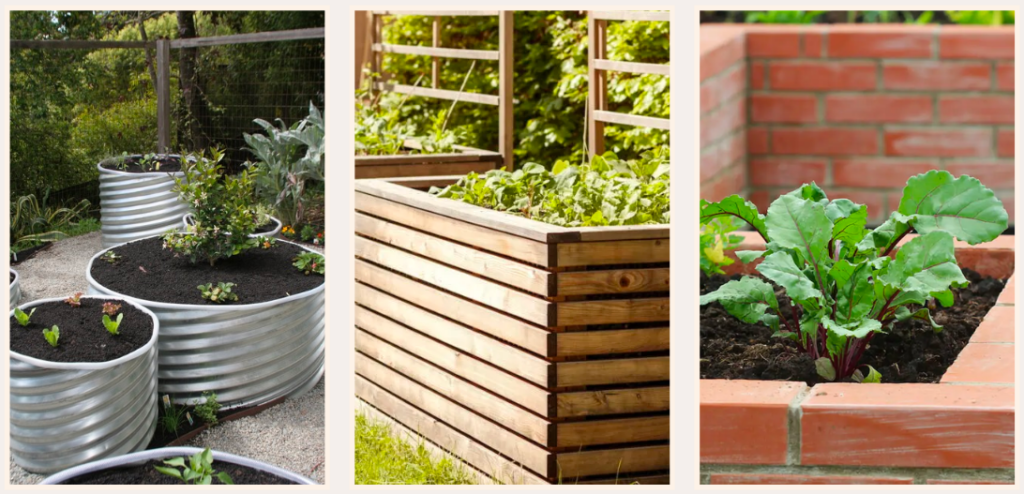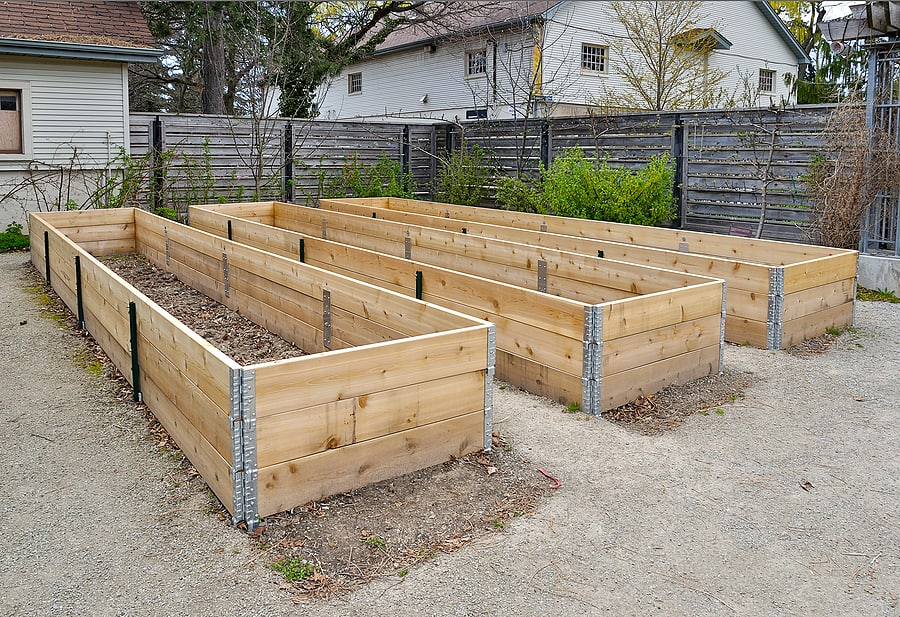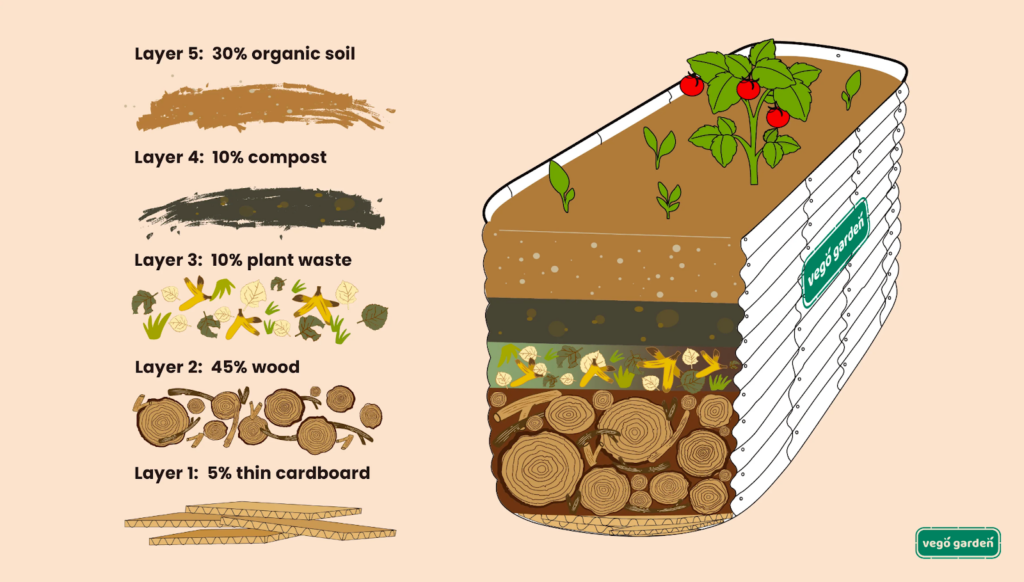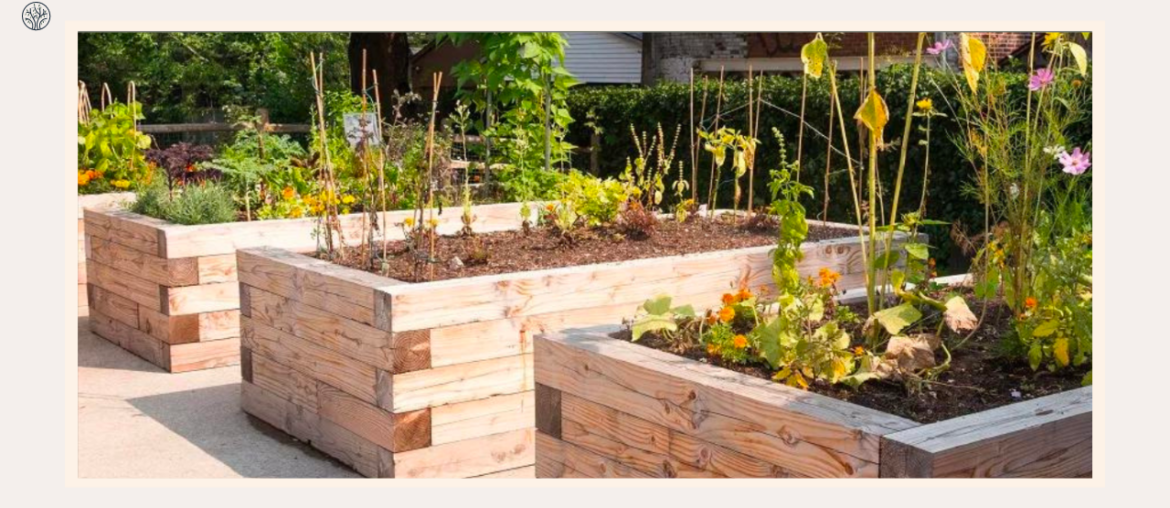Raised garden beds are arguably the ultimate solution for non-ideal gardening conditions, such as confined spaces, hard clay soil with bad drainage, or marshy yards. With the right setup and proper, optimal use, raised beds can bring a lot of benefits to your gardening experience, thus delivering promising yields.
However, eagerness without thoughtful preparation may lead to actions that cost you the whole crop. To help you avoid common raised bed mistakes, this article provides a step-by-step guide on how to build a raised garden bed with no special skills required.
What Is A Raised Garden Bed?
A raised garden bed (or raised bed) is the term referring to a freestanding gardening box/frame built on the ground, aiming to create an independent growing area located above, separate from the ground. Since raised garden beds are created to solve the problem of unsuitable soil or terrain for gardening, the soil layer in the beds is always higher than in the surrounding area. This is to ensure good-quality soil and proper growing conditions for fruits and vegetables to thrive.
If you’re a beginner in gardening, you may not be familiar with the concept of urban gardening. Raised beds are widely utilized to create urban gardens for their versatility, especially in the context of not having enough arable land and agriculture due to urbanization. The word “bed” says it all. Raised beds provide a garden space that is small enough to work without actually entering the growing area.
The Benefits of Raised Garden Beds
Flexible Location
Raised beds can come in different sizes and styles, and the bed materials are also very diverse. Therefore, you’re open to a variety of options that can help you build your garden anywhere. On clay, hard soil, or even concrete, as long as that area gets enough sunlight and water, it should work.
Better Drainage
With flood-prone areas or marshy yards, ground gardens often have to face inundation in the heavy rainy season. Raised beds, on the other hand, are the perfect solution to drainage problems. With an average depth of 11″ to 12″, in combination with amended, loose soil, raised beds allow for faster drainage, giving plants extra breathing space in wet conditions.
Soil Management
The choice of soil type is yours. Regardless of the terrain where you build your garden, you have all the control over modifying the soil according to different growing needs with raised garden beds. Simply fill your raised beds with your own soil mixed with any needed nutrients.
Optimal Gardening Experience
Thanks to its flexibility, a raised garden bed can greatly improve your gardening experience. You can choose the height of a raised bed to your liking, and this is indeed the savior for gardeners with back and joint problems, or who simply want to garden more comfortably. There are even raised beds specially designed to meet the needs of people with physical disabilities, ensuring anyone can garden with ease.
Build A Raised Garden Bed: Step By Step
How To Prepare Raised Garden Beds
To build a raised garden bed the right way, here’s what you will need:
Frame Material

There is a variety of materials to construct a raised garden bed. Some of the most popular options include:
- Untreated wood: As a beginner, you can try some basic options such as hemlock and redwood, since they are not too expensive and are relatively durable. If you’re looking for higher-grade materials, consider cedar or recycled wood made from plastic bottles. These types of wood are insect and rot resistant and can last 10 to 15 years or more.
- Concrete or brick: You can layer bricks or concrete blocks to create your raised bed frames or build them on top of each other to form taller sides if you have enough materials. However, concrete may increase the soil pH over time, so you should take this into consideration.
- Steel: Steel beds have thin edges so they won’t take up as much as wooden or brick beds. Also, steel beds can withstand both hot and cold conditions without significant temperature changes. They are built to last. Both new and reused steel are fine. Reclaimed steel, corten steel, or powder-coated steel are some familiar options that you can try.
- Natural stone: A budget-friendly and environmentally friendly option, but requires a bit of time and effort to find the ideal ones and move them around. You can find this material anywhere, on your property, on the road, or from hardscaping material distributors.
Above are just some of the most commonly used raised bed materials. In fact, you can use any materials you have at hand to form a raised bed. However, it’s important to understand the pros and cons of each material before making your decision.
Lining Material
While there is still a debate about whether to line a raised garden bed or not, you should note that the benefits of lining raised beds actually outweigh the disadvantages. It’s beneficial in insulating the soil from extreme heat or cold from the surrounding ground, preventing weeds, and at the same time deterring moles and gophers.
Depending on factors such as the type of soil you use, raised bed material, the problems you face, and your budget, you can choose from the following lining materials:
- Fabric: Including landscape fabric, canvas, burlap, etc. Landscape fabric is our top choice. It’s breathable and thin enough to allow air, water, and nutrients to pass through, while thick enough to prevent unwanted weeds from growing.
- Plastic: Plastic garden liner is the ideal choice if you need to keep the soil moist by preventing drainage. However, whether this material is toxic or not might be a matter of concern, so make sure to consult the manufacturer.
- Metal: Use metal hardware cloth or rabbit/chicken wire to prevent gophers and moles from digging into your raised beds from below while ensuring adequate drainage. As you’re using it for your garden, make sure your hardware cloth is made from stainless steel and has not been treated with any chemicals.
- Cardboard: This is a cheap, readily available option that you can find around the house. However, keep in mind that this is not a permanent solution as it will decompose quickly.
Topsoil
Ask yourself questions: What kind of topsoil should you use? How much? If you’re not sure, ask the pros around you, or simply use a pre-mixed soil that already contains compost and organic matter. Go for dark and crumbly top soil options that have an earthy smell. Soils with a high clay content, funky smell, or sticky texture are not recommended.
Making a Raised Garden Bed
Size and Space
To begin with, you need to determine where to place your raised beds. It has to be a location that can ensure at least 6 to 8 hours of direct sunlight per day for your plants.
Once you’ve found the ideal space, remove the weeds there (if any) before placing the beds. Then, plan the ideal length and width of each bed according to your available space and materials. A 4×4 raised garden bed is a good start for you as a beginner, and you can gradually expand your garden later.
While the length of each bed is flexible, you need to ensure a proper width so that you keep the plants within reach without stepping on the soil. A 2 1/2 feet wide raised bed is ideal if one side of it is blocked by any obstacles. If you can reach the bed from both sides, keep it 3-5 feet wide.
Framing The Bed

Before framing your raised beds, decide what plants you are going to grow first. For crops with deep roots such as potatoes, carrots, tomatoes, etc., the bed needs to be at least 12 to 18 inches deep to ensure nutrients are accessible. In the case of shallow rooted crops, the minimum soil depth should be 6 inches.
In terms of materials, you can consider our recommendations above, or choose any options you can find. However, say no to painted or pressure treated wood. These materials are often preserved with chemicals, and the chemicals can leach into your soil easily. This is crucial, especially if you’re growing a vegetable garden or any kind of food that you will eat afterwards.
Lining The Bed
This step is optional. With healthy ground soil, you can skip this step. However, if you’re planting on concrete ground or are concerned about the quality of the available ground soil, lining is necessary to insulate the soil and prevent pests and weeds. Again, you can utilize the lining materials we mentioned above depending on your needs.
Layering The Bed

How to layer raised garden beds? This is the last step before we actually start planting. Proper layering will help strengthen the root systems of the plants, making them healthier and more productive at harvest time. Follow the instructions below:
- Layer 1: Liner (fabric, metal, or plastic if needed). You can use cardboard if there are no specific problems about ground soil to deal with.
- Layer 2: Branches, bark, sticks, or leftover wood chips. This layer plays the role of retaining moisture, limiting weed growth, and regulating soil temperature.
- Layer 3: Include mulch of leaves, hay, or grass clippings. This layer decomposes very quickly, acting as a type of fertilizer that provides nitrogen for the soil.
- Layer 4: Compost. Ready-made compost mixes work well, but if possible, try to utilize leftovers from the kitchen (egg shells, fruit/vegetable skins, coffee grounds, etc.). This layer provides nutrients for your plants to thrive, as well as stabilize and strengthen their root systems.
- Layer 5: Topsoil. Always use high-quality soil to ensure the healthiest, most nutrient-rich environment for your plants. Organic topsoil is the ideal choice.
Once your garden bed is done layering, water it thoroughly, and you’re now ready to plant or transplant your vegetables into the raised bed.
Planting In Raised Garden Beds
You can plant almost any type of plant, flower, or vegetable in a raised garden bed. There is a variety of vegetables that grow well in raised beds, such as lettuce, radishes, cucumbers, or strawberries. However, some vegetables like tomatoes and beans need a trellis, so you may need to set up some for support. As a beginner, start simple by selecting 2-3 plants that are easy to grow, and then experiment more as you gain experience.
Also, make sure to understand the companions of each plant in advance. Some flowers are very suitable for growing in raised garden beds since they are the companions of many different vegetables. For example, if you’re growing cucumbers, including nasturtium and marigold flowers in your garden can help prevent cucumber beetles.
Grow Now!
We hope that with all the information and guidance in this article, you are now crystal clear on how to build a simple raised garden bed, even if you’re not a DIY expert. What could be better than being able to enjoy healthy, organic food from your own rooftop garden? This is not a dream. Read our guide and start your new raised garden bed now towards a greener lifestyle.





